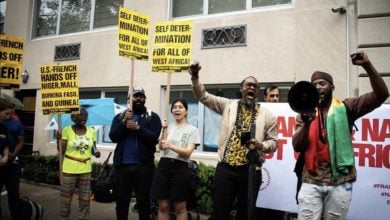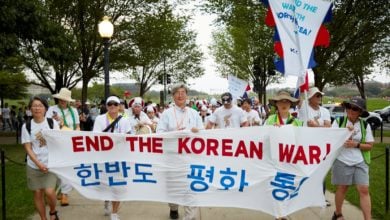On Monday, Dec. 17, United States and North Korea will return to what is known as the six-party negotiations. Joining them will be South Korea, Japan, China and Russia. The U.S. and North Korean governments will meet bilaterally the day before the talks.
North Korea will return to the table as an announced nuclear power.
After North Korea announced the test of its first nuclear bomb on Oct. 9, the United States and its imperialist and pro-imperialist allies went into a frenzy, threatening and verbally attacking the country. The United States rallied the U.N. Security Council to condemn North Korea.

North Korean mass games celebrate independence and the ongoing socialist revolution. |
But North Korea did not blink. North Korea made the point that the United States possesses thousands of nuclear weapons and is still technically at war with the country. The U.S. government refuses to sign a formal peace treaty ending the U.S.-Korean war of 1950-53.
The government of North Korea made it evident that its primary goal was to compel the United States to end the hostility and normalize relations between the two countries. Bush had menacingly labeled North Korea part of the “axis of evil” along with Iraq and Iran.
An important part of the recent U.S. campaign against North Korea has been run by the U.S. government’s capitalist media appendages. Media images frequently depict North Korea as a sad, colorless place. The imperialists want to make North Korea seem as alien to people in the United States as possible, making their goals more palatable.
To mount an effective defense of North Korea against imperialist threat and aggression, it is helpful to get a more accurate picture of the achievements of socialist construction in North Korea, while explaining the hardships that exist as a result of imperialism
Socialist planning and economic strides
The Korean revolution began at the end of World War II, breaking the northern part of the Korean peninsula free of Japanese colonialism.
In August 1945, the Soviet army established the “Soviet Civil Authority” to govern the north. The United States took control of the south.
In 1946, Kim Il-Sung, the central leader of the anti-colonial resistance against Japan, became the leader of the North Korean Provisional People’s Committee. This governing body expropriated private property, threw out the capitalists and established a workers’ state under the leadership of the Korean Workers’ Party. The economy was reorganized as a socialist planned economy to meet the needs of workers and peasants.
The North Korean Provisional People’s Committee was the predecessor to the formal establishment of the Democratic People’s Republic of Korea in September 1948.

North Korea’s capital Pyongyang after relentless U.S. bombing, 1953. |
From 1950 to 53, the U.S. government led U.N. troops in a war aimed at destroying the newly formed workers’ state and turning the whole Korean peninsula into a U.S. colony. In the fierce war, more than five million Koreans died. The U.S. military committed massive war crimes against the people and unrelentingly bombed the north.
In the end, however, the U.S. government was forced to stop at the 38th parallel—now the border that separates North and South Korea. More than 28,000 U.S. occupation troops are still stationed at the border and around South Korea.
With the north decimated by U.S. bombing, the socialist government began the process of rebuilding the state in 1953.
Before and during World War II, the Japanese and their Korean allies owned and controlled the peninsula’s entire capitalist economy. By 1946, the communist-led North Korean governing authority had nationalized 70 percent of the country’s industry. Ninety percent was nationalized less than three years later.
Land was redistributed on a huge scale to poor peasants. By 1950, all farmland was collectivized and agricultural production was up dramatically. The north’s main trading partner was the Soviet Union, which traded with the workers’ state on a favorable basis for many years to come.
The North Korean government’s first Three-Year Plan of 1954-56 achieved a phenomenal 30 percent increase in overall economic growth. The plan repaired the massive damage caused by the war and brought industrial production back to pre-war levels.
Much effort was invested into large-scale industry and building productive capacity. As a result of these revolutionary changes, the population enjoyed great social gains in food, housing and access to health care.
Economic growth in North Korea continued throughout the 1950s, with increases in the 60s and 70s as well. The gross national product during this era far outstripped that of capitalist South Korea, which was a U.S. satellite. In 1960, North Korea was the second most industrialized nation in East Asia, trailing only imperialist Japan.
By the 1980s, the huge influx of foreign capital into South Korea, mainly from the U.S. imperialists, eventually increased the South’s GNP, making it much higher than the North. Of course, this economic boost was accomplished at the expense of South Korean workers’ and peasants’ living standards and civil rights.
Current economic difficulties
The media has blamed socialism for North Korea’s current economic difficulties. But the overthrow of the socialist camp coupled with external imperialist pressure and sanctions are the root of its problems.

A noodle factory in North Korea. |
North Korea has suffered several terrible blows to its economy since the early 1990s. From 1989-91, counterrevolutions swept through the socialist bloc countries and the Soviet Union. Trade with these workers’ states accounted for 71.4 percent of North Korea’s trade and nearly all of its oil. Their disappearance had a devastating impact on North Korea’s economy.
It forced North Korea to trade with “hard” currency—imperialist currencies “stabilized” by the amount of wealth stolen from labor. This caused enormous trade imbalances between North Korea and new capitalist trading partners. North Korea had to integrate its economy, however minimally, into the world capitalist economy.
The United States has maintained sanctions against North Korea for 50 years. These sanctions include North Korea not being able to access loans from international banks to develop the country. North Korea has been unable to get trade credits or a favorable trading status with other nations. China is its main trading partner.
Compounding these events, North Korea suffered a series of natural disasters in 1995-97, including devastating floods and droughts. The massive devastation caused by hurricane Katrina in New Orleans pales in comparison to the disasters that have hit Korea. These natural disasters resulted in severe grain shortages and many deaths.
At this time, it is estimated that as much as 16 percent of the North Korean population is experiencing malnutrition, particularly in the province of North Hamgyong, the northernmost province bordering Russia. The average daily ration is about 600 calories or about one-quarter of a person’s needed caloric intake.
Rather than increasing aid, international relief agencies like the U.N. World Food Program have actually cut aid to North Korea. The United States has tightened its already punitive sanctions.
Improvements in workers’ lives

Pyongyang today, a beautiful modern city. |
Despite its recent economic difficulties, North Korea has accomplished dramatic improvements in the lives of workers and peasants.
North Korea’s universal healthcare system has vastly improved the country’s health and almost doubled the average age of life expectancy.
In the late 1930s, the life expectancy for Koreans was 38 years. By 1990, North Korean life expectancy advanced to 66 for men and 73 for women according to the United Nations. Infant mortality rates greatly improved and the discrepancy between urban and rural mortalities have narrowed.
Healthcare and preventative health measures are prioritized in socialist planning, which has substantially increased the number of hospitals, clinics and the overall healthcare infrastructure since the 1950s. There is 1 physician for every 370 people. Health clinics are built next to large factories and mines so that workers can easily access them.
Education and housing are also rights guaranteed to all. There is universal literacy in North Korea.
Housing in urban areas is set at .3 percent of a worker’s monthly salary. Heat and electricity bills are set at 3 percent of a worker’s salary.
North Korea’s capital and largest urban center, Pyongyang, was rebuilt from the ground up after the Korean War and is now a thoroughly modern capital with contemporary high rise buildings. Over 2 million people live in the city. Pyongyang is full of majestic monuments and expansive parks and green spaces that all workers can utilize.
Twelve percent of the nation’s population lives in the capital; over 60 percent of North Korea’s population is urban. Unlike racist gentrification in the United States that pushes out the working class, the city planning and development of Pyongyang is for the benefit of workers.
North Korea’s communist leadership also has prioritized ending women’s oppression. In the interest of national development, women are encouraged to participate fully in the economic life of the country. There are accessible state-run nurseries for working women. Women who have three or more children can cut their work week to 30 hours and still receive 40 hours pay. Birth control is available free at health clinics.
To counter residual feudal social relations like the preference of male children over female, the country’s media showcases the achievements of women in North Korean society.
Significant numbers of women attain a university education. Many women focus their studies in medicine, biology, foreign languages or literature.
These impressive gains made by the revolution in North Korea are not reported by the capitalist press. But it is important that revolutionaries and progressive people in the United States understand the great sacrifices and accomplishments of the Korean people and their government.
In the face of sustained U.S. war threats and economic sanctions, North Korea has still remained a revolutionary country that values people over capitalist profit and greed. It has kept foreign capitalist investment from massively exploiting its people and taking over the country. This is the real crime of North Korea in the eyes of the imperialists.





